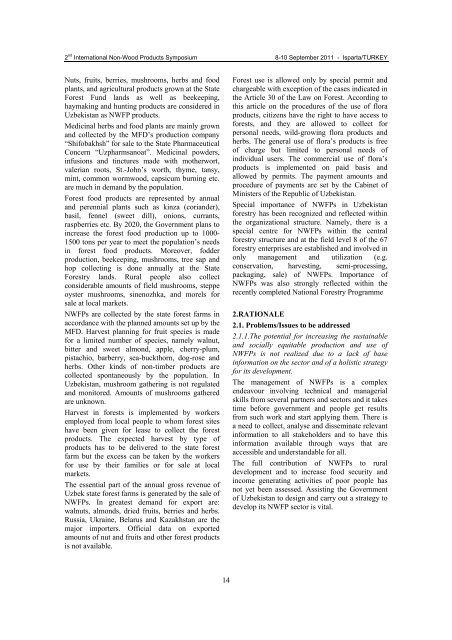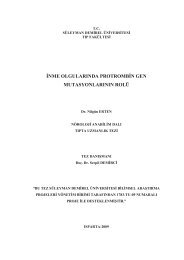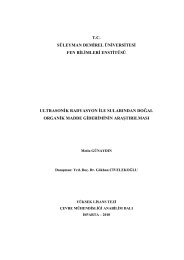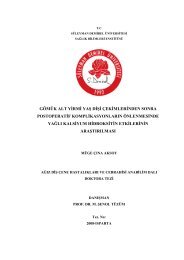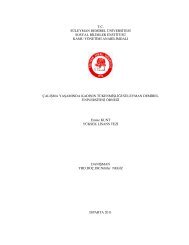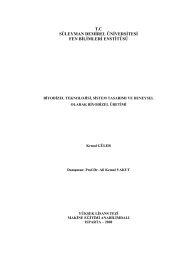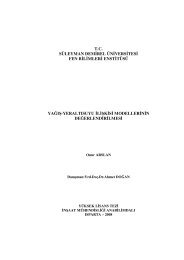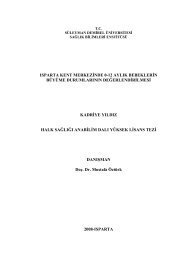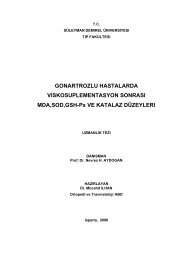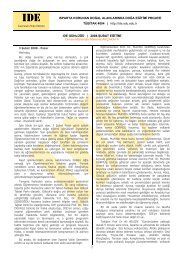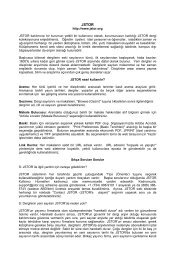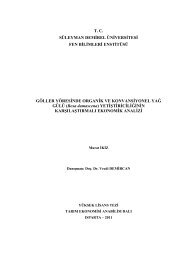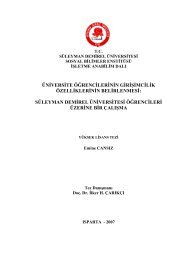Proceedings Book / Bildiri Kitabı - Orman Fakültesi - Süleyman ...
Proceedings Book / Bildiri Kitabı - Orman Fakültesi - Süleyman ...
Proceedings Book / Bildiri Kitabı - Orman Fakültesi - Süleyman ...
You also want an ePaper? Increase the reach of your titles
YUMPU automatically turns print PDFs into web optimized ePapers that Google loves.
2 nd International Non-Wood Products Symposium 8-10 September 2011 - Isparta/TURKEY<br />
Nuts, fruits, berries, mushrooms, herbs and food<br />
plants, and agricultural products grown at the State<br />
Forest Fund lands as well as beekeeping,<br />
haymaking and hunting products are considered in<br />
Uzbekistan as NWFP products.<br />
Medicinal herbs and food plants are mainly grown<br />
and collected by the MFD’s production company<br />
“Shifobakhsh” for sale to the State Pharmaceutical<br />
Concern “Uzpharmsanoat”. Medicinal powders,<br />
infusions and tinctures made with motherwort,<br />
valerian roots, St.-John’s worth, thyme, tansy,<br />
mint, common wormwood, capsicum burning etc.<br />
are much in demand by the population.<br />
Forest food products are represented by annual<br />
and perennial plants such as kinza (coriander),<br />
basil, fennel (sweet dill), onions, currants,<br />
raspberries etc. By 2020, the Government plans to<br />
increase the forest food production up to 1000-<br />
1500 tons per year to meet the population’s needs<br />
in forest food products. Moreover, fodder<br />
production, beekeeping, mushrooms, tree sap and<br />
hop collecting is done annually at the State<br />
Forestry lands. Rural people also collect<br />
considerable amounts of field mushrooms, steppe<br />
oyster mushrooms, sinenozhka, and morels for<br />
sale at local markets.<br />
NWFPs are collected by the state forest farms in<br />
accordance with the planned amounts set up by the<br />
MFD. Harvest planning for fruit species is made<br />
for a limited number of species, namely walnut,<br />
bitter and sweet almond, apple, cherry-plum,<br />
pistachio, barberry, sea-buckthorn, dog-rose and<br />
herbs. Other kinds of non-timber products are<br />
collected spontaneously by the population. In<br />
Uzbekistan, mushroom gathering is not regulated<br />
and monitored. Amounts of mushrooms gathered<br />
are unknown.<br />
Harvest in forests is implemented by workers<br />
employed from local people to whom forest sites<br />
have been given for lease to collect the forest<br />
products. The expected harvest by type of<br />
products has to be delivered to the state forest<br />
farm but the excess can be taken by the workers<br />
for use by their families or for sale at local<br />
markets.<br />
The essential part of the annual gross revenue of<br />
Uzbek state forest farms is generated by the sale of<br />
NWFPs. In greatest demand for export are:<br />
walnuts, almonds, dried fruits, berries and herbs.<br />
Russia, Ukraine, Belarus and Kazakhstan are the<br />
major importers. Official data on exported<br />
amounts of nut and fruits and other forest products<br />
is not available.<br />
Forest use is allowed only by special permit and<br />
chargeable with exception of the cases indicated in<br />
the Article 30 of the Law on Forest. According to<br />
this article on the procedures of the use of flora<br />
products, citizens have the right to have access to<br />
forests, and they are allowed to collect for<br />
personal needs, wild-growing flora products and<br />
herbs. The general use of flora’s products is free<br />
of charge but limited to personal needs of<br />
individual users. The commercial use of flora’s<br />
products is implemented on paid basis and<br />
allowed by permits. The payment amounts and<br />
procedure of payments are set by the Cabinet of<br />
Ministers of the Republic of Uzbekistan.<br />
Special importance of NWFPs in Uzbekistan<br />
forestry has been recognized and reflected within<br />
the organizational structure. Namely, there is a<br />
special centre for NWFPs within the central<br />
forestry structure and at the field level 8 of the 67<br />
forestry enterprises are established and involved in<br />
only management and utilization (e.g.<br />
conservation, harvesting, semi-processing,<br />
packaging, sale) of NWFPs. Importance of<br />
NWFPs was also strongly reflected within the<br />
recently completed National Forestry Programme<br />
2.RATIONALE<br />
2.1. Problems/Issues to be addressed<br />
2.1.1.The potential for increasing the sustainable<br />
and socially equitable production and use of<br />
NWFPs is not realized due to a lack of base<br />
information on the sector and of a holistic strategy<br />
for its development.<br />
The management of NWFPs is a complex<br />
endeavour involving technical and managerial<br />
skills from several partners and sectors and it takes<br />
time before government and people get results<br />
from such work and start applying them. There is<br />
a need to collect, analyse and disseminate relevant<br />
information to all stakeholders and to have this<br />
information available through ways that are<br />
accessible and understandable for all.<br />
The full contribution of NWFPs to rural<br />
development and to increase food security and<br />
income generating activities of poor people has<br />
not yet been assessed. Assisting the Government<br />
of Uzbekistan to design and carry out a strategy to<br />
develop its NWFP sector is vital.<br />
14


